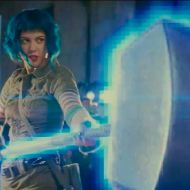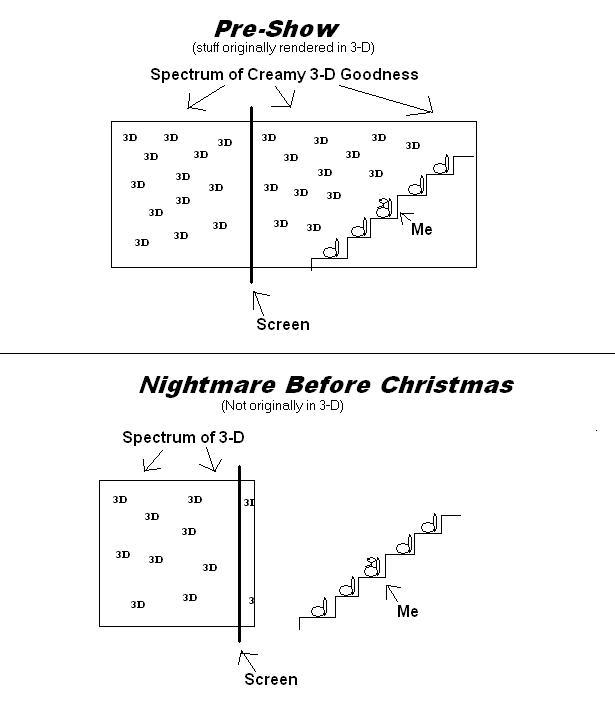My Popcorn Is Stale: Stop Throwing Things At Me!
I remember seeing Chicken Little on the big screen back in 2005 at a theater chosen to be part of the first wave of Disney’s master plan to spread digital 3-D across America. Before the movie, as the screen flashed “Put your glasses on now”, some guy behind me muttered “This better be good.” Well.. the movie itself wasn’t very good. I, as well as the audience, was wowed by the awesome power of RealD’s new system. But to reiterate: the movie really sucked.

This happened.
For a period after that, a few scant Disney CG and live action films were released in 3-D. While I continued to be impressed by the process, I was not happy with the movies using it. The 3-D trailer for Journey to the Center of the Earth had Brendan Frasier spitting on the audience. I did not appreciate that.
That trailer was mixed in with Meet the Robinsons and a few other made-for-3-D previews at the beginning of the re-mastered and post-converted Nightmare Before Christmas. Though all the trailers were stupid, they looked fantastic visually. Things were popping out and flying every which way. It was exciting! Then the movie started, and disappointment slowly crept in. There were traces of depth, but the world wasn’t pulling me in. Not using the technology, anyway. Shortly after, I made an MS Paint diagram of how disappointing it was:
On the plus side, I was getting to see Nightmare Before Christmas in an actual theater with an audience so I didn’t complain too loudly, but I was promised a 3D experience! You can see the trailer here.
See? Does that not reek of awesome promises?
Cut to late 2009. Avatar, James Cameron’s 12-year furry fetish masterwork hit theaters in three brilliant mind-altering dimensions. Trust me when I say this: Avatar was the best use of 3-D I had ever seen to date. There was immense depth, objects close enough to admire without poking me in the eye, and the imagery occupying the space was realistic and beautiful. The movie itself wasn’t bad either. Original? No, but who cares? I had fun.
Finally, what I had been waiting for! A movie to come along that would fully realize the storytelling potential of 3-D, whilst throwing out the cheap gimmickry for which the technique had come to be known. Coraline also achieved this, but it did not do so at the sheer scale of Avatar. Avatar is almost not as good a movie without that extra dimension. (Don’t get me wrong, I enjoyed Coraline a bunch more than Avatar story-wise, but I didn’t come out of the theater completely dazzled.) Not to say Avatar is complete shit without 3-D- it’s not bad. But rather the third dimension is interwoven into the moviemaking and plays as important a part as the editing, acting, lighting, etc; it wasn’t just there to add an extra $10 onto the ticket. This is how all innovations of film should be used, like sound, color, and widescreen before it. Oh, but let’s not forget that 3-D isn’t new. Let’s go back a bit.

The 1950’s: television is born. The moviemakers of America feel threatened by the prospect that no one will ever have to leave their homes again to get their sweet, sweet moving picture fix. So they think of a few ideas to lure people out of their homes with the promise of new viewing experiences. Now, some of these were really stupid. Like Smell-o-vision, where they pumped scents through the theater air vents at certain times during the movie, wrecking the ventilation system in the process. Or the Tingler, which literally shocked the place where you sat.
But 3-D technology had some promise. The only thing it required was some extra film, a rig for two cameras, and millions of pairs of glasses. The only problem was, like most new technologies, nobody knew how to use it as a filmmaking tool. Actors threw things at the camera: spears, blood, guts, anything. It was simply a multi-million dollar way to say “HA! You flinched!”. Enter Alfred Hitchcock, film magician extraordinaire. He sought to use the extra dimension given to him to heighten the suspense in his film “Dial ‘M’ for Murder”. He didn’t see a gimmick, he saw a potential to tell the film’s story better.
Unfortunately, shortly after Hitchcock made his first and only 3-D movie, the craze died down. Over the decades, 3D has stuck around. But only now, and with the new digital process (and more recently the gigantic commercial success of Avatar) has it gained any kind of lasting steam.
Finally, the studios have begun to see the potential for 3-D to make them money. This has lead to practices such as taking movies already in 2D production and having technicians make cutouts of the actors in post to make a cheap 3-D effect. This is why critics complain that the extra dimension they paid for seems non-existent: it was shot that way. Oh, and did I mention the polarization process also makes the images darker, taking away any detail the cinematographer put into the frame? So yeah. There’s that too. But you know what? This abuse of extra dimensional technique could pay off in good ways. With studio money backing it, artistic directors would be able to experiment with the technique and figure out how to use it right. I’m looking forward to Peter Jackson’s 3-D “The Hobbit”, (which is being shot for it). I would also like to see what other great directors like Scorsese, Spielberg, or Del Toro could do with this technology.
Now, while I support 3-D as a tool of cinema, I must also have a disclaimer: Every movie does not need to be in 3-D. Just like shooting in color is a completely different art than shooting black and white, the art of shooting in 2-D has been developed and re-developed by some great minds over a long period of time. Some very awesome visual masterpieces were released last year that viewed just fine in classic 2-D. Christopher Nolan fought to keep inception in 2-D, just as he’s fighting to not shoot Batman 3 in 3-D. With the commercial failure of Scott Pilgrim in theater, the 3-D post-conversion process would have only added to the box office loss. Not to mention, it would have taken more time and money than usual with the onomatopoeia graphics, lens flares, and flashing fight sequences. However, quality and content-wise, Scott Pilgrim didn’t need the added dimension; the source material was already in a paper-flat black and white format, and to post-convert it into 3-D would’ve missed the point.
So my last words to the studios: Keep making 3-D, but use wisely and where applicable. And leave that decision to the artists.




